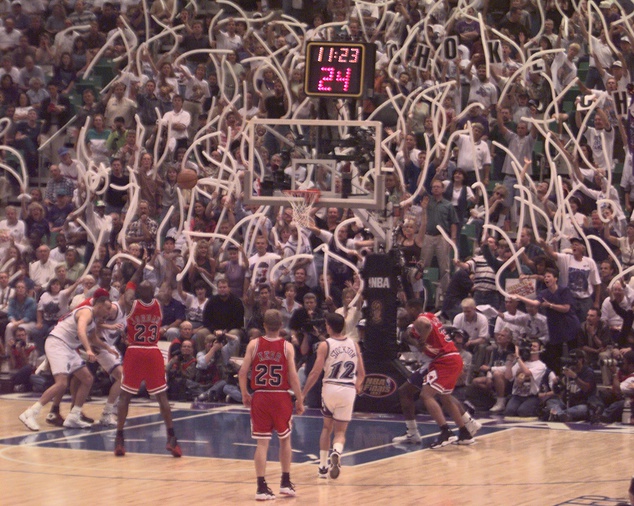In the 2025 NBA playoffs, Shai Gilgeous-Alexander has emerged as a lightning rod for discussion, with critics accusing him of “foul-baiting” to inflate his scoring and secure wins for the Oklahoma City Thunder. Averaging 9.2 free throw attempts (FTA) per game, Gilgeous-Alexander’s ability to draw fouls has sparked heated debates among fans and analysts. However, a look back at Michael Jordan’s playoff performances reveals that the Chicago Bulls legend consistently surpassed Gilgeous-Alexander’s FTA numbers across multiple postseason runs, raising questions about the validity of the foul-baiting narrative and how it compares to Jordan’s era. Let’s break down the numbers and the context behind this controversy.
Michael Jordan’s Playoff Free Throw Attempts
Michael Jordan, widely considered the greatest basketball player of all time, was a master at drawing fouls and getting to the free-throw line, particularly in the playoffs. Here are his average FTA per game in select postseason years:
- 1985 Playoffs: 14.5 FTA per game
- 1986 Playoffs: 13.0 FTA per game
- 1987 Playoffs: 13.0 FTA per game
- 1988 Playoffs: 9.9 FTA per game
- 1989 Playoffs: 13.5 FTA per game
- 1990 Playoffs: 9.9 FTA per game
- 1996 Playoffs: 10.4 FTA per game
- 1998 Playoffs: 10.6 FTA per game
Jordan’s early playoff years, particularly 1985 (14.5 FTA) and 1989 (13.5 FTA), showcase an extraordinary ability to earn free throws, often against physical, bruising defenses like the Detroit Pistons’ “Bad Boys.” Even in his later years, such as 1996 and 1998, when he leaned more on his mid-range game, Jordan still averaged over 10 FTA per game. His relentless drives, acrobatic finishes, and ability to absorb contact made him a nightmare for defenders, resulting in frequent trips to the line. These numbers weren’t just a byproduct of his aggression—they were a strategic weapon that boosted his scoring and disrupted opposing defenses.
Shai Gilgeous-Alexander’s 2025 Playoff Performance
In the 2025 playoffs, Shai Gilgeous-Alexander averaged 9.2 FTA per game, a strong figure for a guard in the modern NBA. His game, built on slick ball-handling, hesitation moves, and a knack for drawing contact, has made him one of the league’s most effective scorers. However, his FTA have drawn scrutiny, with critics arguing that he engages in “foul-baiting”—exaggerating contact or manipulating defenders into fouls to rack up points at the line. This perception has fueled debates about whether his free throws are earned through skill or gamesmanship, with some claiming it gives him an unfair edge in tight playoff games.
Yet, when compared to Jordan’s playoff FTA, Gilgeous-Alexander’s 9.2 attempts pale in comparison to Jordan’s peak years (1985, 1986, 1987, 1989) and are only slightly below his later years (1996, 1998). Even in Jordan’s “lower” FTA seasons (1988, 1990), he still matched or exceeded Gilgeous-Alexander’s 2025 mark. This raises a critical question: if Jordan’s high FTA were celebrated as a product of his aggressive style, why is Gilgeous-Alexander’s approach labeled as foul-baiting?
The Foul-Baiting Debate: Jordan vs. Gilgeous-Alexander
The criticism of Gilgeous-Alexander as a “foul-baiter” often stems from the modern NBA’s evolving style and officiating. Today’s game emphasizes perimeter play and three-point shooting, with stricter rules against physical defense compared to the 1980s and 1990s. Moves like pump fakes, leaning into defenders, or initiating contact on drives—tactics Gilgeous-Alexander employs—can be seen as exploiting these rules. Social media posts on X have amplified this narrative, with some fans calling his style “cheap” or arguing that it detracts from the game’s purity. However, these tactics are not new; they’re an evolution of skills players like Jordan mastered decades ago.
Jordan, too, was adept at drawing fouls through savvy play. His ability to contort his body mid-air, absorb contact, and still finish plays often resulted in and-one opportunities or trips to the line. While Jordan’s era allowed more physicality (e.g., hand-checking), he faced defenses designed to punish slashing guards. Yet, he consistently drew fouls at a higher rate than Gilgeous-Alexander’s 2025 average. If anything, Jordan’s FTA numbers suggest he was just as—if not more—effective at “baiting” fouls, though it was rarely framed as such. Instead, it was seen as a hallmark of his brilliance.
The difference lies partly in perception and context. Jordan’s physicality and highlight-reel dunks overshadowed any foul-drawing criticism, while Gilgeous-Alexander’s smoother, more calculated style draws attention to the mechanics of his foul-drawing. Additionally, the modern NBA’s emphasis on analytics and efficiency has made free throws a focal point, amplifying scrutiny of players who excel at getting to the line.
Era and Style: Why the Comparison Matters
Comparing Jordan and Gilgeous-Alexander requires understanding the NBA’s evolution. In Jordan’s era, physical defense was the norm, and fouls were often harder-earned against rugged opponents. Jordan’s high FTA reflected his ability to overpower or outmaneuver defenders in a league where contact was expected. Gilgeous-Alexander, operating in a less physical era, uses finesse and timing to draw fouls, capitalizing on referees’ tendencies to protect offensive players. Both players adapted to their respective eras, exploiting the rules and defensive schemes to maximize their impact.
Moreover, Jordan was often the sole focus of opposing defenses, especially early in his career, which contributed to his high FTA. Gilgeous-Alexander, while a star, plays in a Thunder system with multiple offensive threats, potentially diluting defensive attention and reducing his FTA compared to Jordan’s peak. Yet, his 9.2 FTA per game remains elite, aligning closely with Jordan’s 1988 and 1990 numbers and not far from his championship years.
Reframing the Narrative
The “foul-baiting” label applied to Gilgeous-Alexander overlooks the skill required to draw fouls consistently. Like Jordan, he uses his basketball IQ, body control, and understanding of defensive positioning to create contact. Drawing fouls isn’t just about gaming the system—it’s about forcing defenders into difficult decisions, a skill Jordan perfected. If Jordan’s 14.5 FTA in 1985 or 13.5 in 1989 were seen as a byproduct of his relentless attack, Gilgeous-Alexander’s 9.2 FTA in 2025 should be viewed similarly: as a testament to his ability to outsmart and outmaneuver opponents.
The criticism of Gilgeous-Alexander also reflects a broader trend in modern basketball discourse, where players who excel at the line—think James Harden or Trae Young—face similar accusations. Yet, free throws are a fundamental part of the game, and players who master this aspect gain a strategic edge. Jordan’s playoff success, bolstered by his FTA, proves this point. Gilgeous-Alexander’s ability to approach Jordan’s later-career FTA numbers suggests he’s not an outlier but part of a lineage of guards who weaponize the free-throw line.
Conclusion
Michael Jordan’s playoff FTA averages, ranging from 9.9 to 14.5 per game, highlight his unmatched ability to draw fouls and dominate games, even against the NBA’s toughest defenses. Shai Gilgeous-Alexander’s 9.2 FTA per game in the 2025 playoffs, while impressive, fall short of Jordan’s peaks but align with his later years. The “foul-baiting” criticism leveled at Gilgeous-Alexander ignores the skill and strategy behind drawing fouls, a craft Jordan himself mastered. Rather than vilifying Gilgeous-Alexander, fans should recognize his ability to exploit defenses as a continuation of a tradition set by legends like Jordan. In different eras, both players have shown that getting to the line is not just a tactic—it’s an art form that can swing playoff games.








